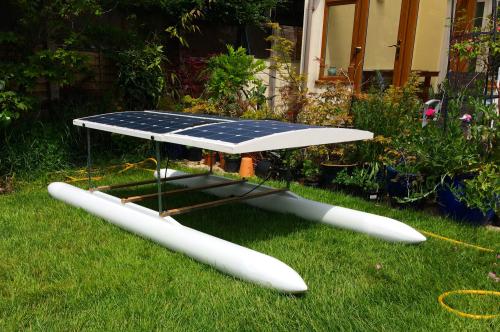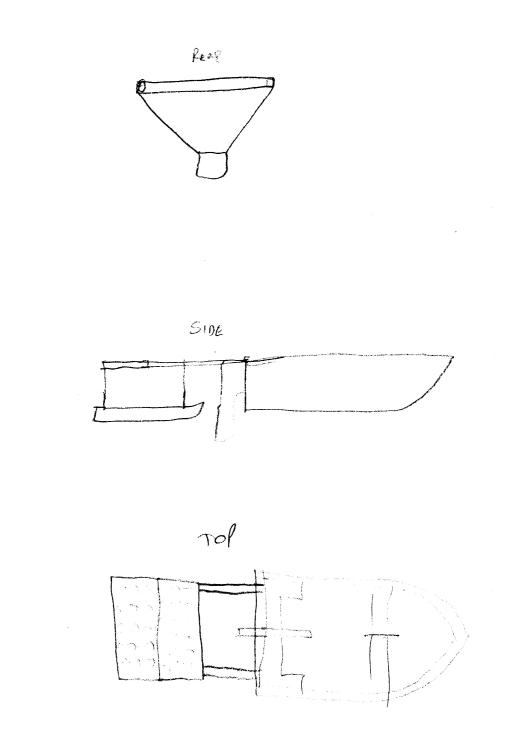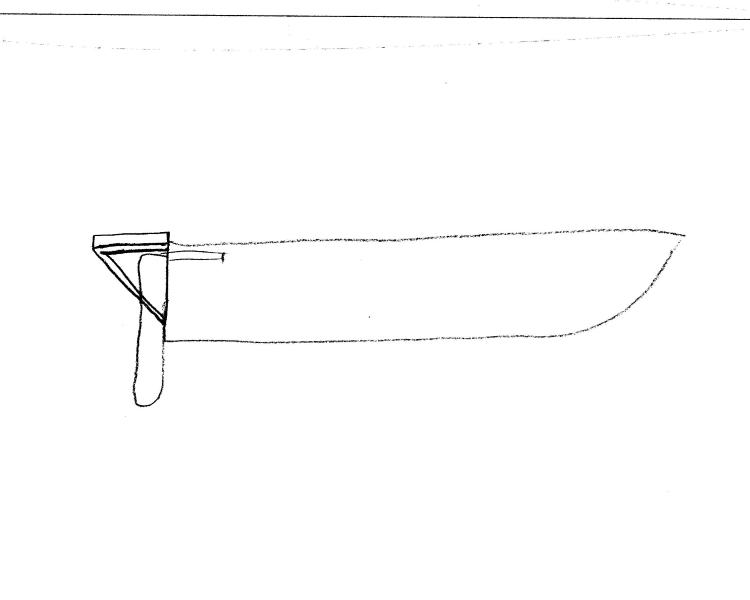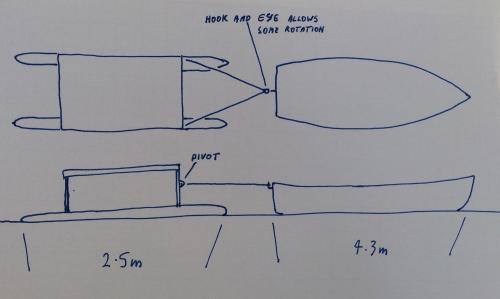Towable array of solar panels
|
|
While you all seem to be building delightful boats I've been mulling over the disappointments of last year, and trying to decide what to do next. I finally decided to build a towable solar panel as the panels mounted as a roof on my little boat make it rather unstable, also a panel placed on the deck is inconvenient and ugly as hell.
 I'm not sure if this is ludicrous or entirely logical. At least I'll have a couple of floats which might work for a future project. |

|
Paul H (admin) |
Re: Towable array of solar panels
|
|
Entirely logical, and creative Alan.
There are plans for floating wind turbines deep offshore, where winds are strong. A tad tricky towed through locks, but the floats add protection. But with stable outriggers a fixed sleeping compartment in the middle becomes possible. At 1.6m beam, 2 panels will be 2m long, delivering 660Watts peak which is a lot of power for narrow hulls. Not sure if my plan is mad or the future! Paul |
|
|
In reply to this post by Alan
Oars or a paddle are easier.
Steve 
|
|
|
Oars and a paddle are just fine!
Paul, with your towable floating solar bed the towing craft can be small, down to a kayak. It has occurred to me that I could leave my solar float somewhere charging its battery while I go off to have a row, or paddle. To keep it under control in locks I'm considering a line from each side of the float to camcleats on the boat; when these are tightened the two vessels would stay aligned, not hinged. Reversing will br virtually impossible. Edit: "Quickly" making cylindrical floats with bullet shaped ends is probably much slower than making plywood hulls with more utility elsewhere. |
|
|
In the days when I taught canoeing and sailing we often practiced towing other craft (dinghies, canoes, etc.) and regularly did it for real to get people/boats home when we had a deadline or the wind dropped etc. We didn't always have a powerboat along so
there were many times when we towed from canoes and dinghies (under oars.)
My memory of it was that it was always hard work..
First you are significantly increasing the drag, if you're towing a catamaran arrangement you could be potentially trebling it. That's a lot more paddling/rowing effort.
Second it caused steering issues. Few unmanned craft followed a straight line behind you when towed. Mostly they yawed from side to side, both a pain for you paddling and also a hazard to other boats. So you will need to design your towed craft
to track straight. Having done that, if you tow from the stern of a canoe it can make turning very difficult, if you tow from the centre (cockpit in a canoe) you could go in a new direction but the towed boat will carry on till you drag it round onto the new
heading, then it will oversteer and need dragging back again. It takes a while to settle down, yanking you back and forth as it does so.
Finally it was nigh impossible for the towed craft to maintain a constant drag. As you paddled (or rowed) each stroke causes the towing craft to surge forward a bit, jerking the towed craft forward. It then carried on coming forward as the towed
craft slowed between strokes creating slack in the towline. So as you put in your next stroke the towing craft takes up the towline slack with a jerk that caused the towed boat to surge forward again. etc. Sometimes the slack was sufficient for it to require
two strokes to catch up with it. So the jerk backward was irregular and unpredictable. Not entertaining in any way.
I'm sure there are solutions to all these issues, but they're worth addressing. I never enjoyed towing anything when paddling or rowing.
Sorry to be a wet blanket... but better you know.
......................................................................
|

|
Jason Mayer |
Re: Towable array of solar panels
|
|
In reply to this post by Alan
Alan it just so happens that I am looking for a way to mount 250W of panels so that I can electric motor perpetually with a small battery for power balancing.
You just took me outside the box I was in....thank you! Jason |
|
|
When I look at the catamaran arrangement it reminds me of those Thames launches with a roof and flexible plastic sides. So how about a solar panel roof? Or would it be top heavy?

|
|
|
I must have explained badly.... This is solar panels towed behind a small boat to create an electric boat which is completely independent of shore power. The solar panels are not forming a roof on the boat because they reduce stability - I've tried that. The panels are not resting on the gunwale of the boat because they look horrible and get in the way - I've tried that. So instead of building a more suitable boat I'm trying the option of towing the solar panels.
Tim, I'll be using a rigid connection to the boat, like towing a trailer with a car, the "trailer" will be towed from a fixed point at the stern, like a tow hitch so it should behave itself - going forward. And I would only row without the "trailer" or if the electrogadgetry breaks down. The battery will probably go in the boat although it could be on the "trailer", I've bought some lithium batteries but because of my cheapskate ways the voltage doesn't match the solar charge voltage so I have to resolve that next. |

|
Chris Waite |
Re: Towable array of solar panels
|
|
In reply to this post by LASER41420
I think if you read from the top, that's where he started, 41420
....and 'top heavy' is where he got to. I agree on your suggestion of oars however - 1. Cheaper 2. More water resistant 3. More reliable 4. More ecofriendly 5. Better exercise Apart from that there's not much in it; though maybe there is - 1. Facing backwards is a pain the conundrums, though a much more acute pain on a narrow waterway than the open sea. Don't try this is a seaway - https://www.youtube.com/watch?v=OsUItqkomXk (You'll need to get into the video to see a pedal yuloh - a Pedyuloh) Or you can simply scull over the stern Chris |
|
|
In reply to this post by Timmo
Obviously an extra hull or two will introduce unavoidable drag, but a tow rod rather than rope should help with the over-run between oar/paddle strokes and to some extent steering issues.
Could the array also be configured to be a giant over-sized rudder?
Greg Chapman
GregAfloat - My Boating Biography |

|
Jason Mayer |
Re: Towable array of solar panels
|
|
Alan,
I think the torsional forces on your two float design could be problematic if you have two trailing arms connecting it to the boat. A single trailing arm with some swivel would be OK though. You boat could be heeling in a different direction to the solar panel structure. How about this to reduce drag. A solid connection to the boat to give it sideways support and just a single float to give it vertical support (ie flotation). That would halve your drag and allow the solar panel to heel with the boat. But it would need a hinged connection to the boat because your boat could be going down a wave and your solar panel still up on top. You couldn't make it one long rigid structure unless it was insanely strong.  Or cantilever it off the back of the boat, but that would only probably work for one large panel not multiple.  |
|
|
In reply to this post by GregHBBR
Next generation light flexible solar panels coating the roof would do the job with an elegant electric powered launch underneath. If stylish hull build starts now then the solar technology might be ready when it is finished
 . .
|
|
|
In reply to this post by Alan
'Towbar' style linkage does indeed address a number of the issues I raised.
|
|
|
Have you considered the extra tax you will have to pay? Certainly on the Norfolk broads and I'm guessing other waterways , that would be a vessel in it's own right and attract more tax.
Guessing it's block area from the photo that would be £34 here. Oh you might need the battery in the trailer low down for stability.. if the wind gets under those solar panels they may go for a swim.. |
|
|
Thanks for all these interesting comments. HBBR broke for me yesterday, I got "error 500" for most threads including this. Back shortly....
|

|
Jason Mayer |
Re: Towable array of solar panels
|
|
In reply to this post by The Q
What?? You have to pay tax to sail on a public waterway....owned by the public....which is you...
Far out that's a first for me. I thought our lawmakers were bad..... I don't even have to register my boat unless the motor is more than 3kW, which would make it a motor boat with a sail, not a sail boat with a motor. In fact the Queensland government doesn't appear to give crap what floating wind driven contraption I am willing to put myself into, as long as I don't charge my passengers for passage. Having said that, we have almost no facilities for boating over here except for boat ramps, which are probably funded by all the motor boat owners, so I can't really complain about lack of facilities if that lack of facilities have cost me nothing.... Jason |
|
|
In reply to this post by Alan
See:
http://uk-hbbr-forum.967333.n3.nabble.com/Major-Changes-and-Bugs-at-Nabble-td4032379.html
Greg Chapman
GregAfloat - My Boating Biography |
|
|
In reply to this post by Jason Mayer
Waterway managed by a public authority would be a better way of describing things. Bear in mind we are a very small heavily populated island, and there's barely a mile of waterway that's not been adapted in some way since the days when we were in the Roman Empire. Most waterways even near their source have had mills and weirs since those days. Then locks were added during the days of canal mania. The landed gentry had huge interest in controlling every aspect of the water that flowed, or was directed artificially, through their land and there was many a conflict of interest. It was inevitable that, in the public interest, their rights were slowly taken over by public bodies with the rights to manage them for the public good. Tolls for rivers and canals (rather than taxes) have been the norm for a couple of millennia in this part of the world.
Greg Chapman
GregAfloat - My Boating Biography |
|
|
This post was updated on .
Yep we call it broads tax , but officially it's a toll. It officially pays for keeping the Broads and rivers dredged, some free to use moorings, Various park rangers that patrol to get the tourists out of trouble and to stop them speeding..
The rates for the Norfolk broads are here.. https://www.broads-authority.gov.uk/boating/owning-a-boat/tolls/annual-toll And the laws the rangers are supposed to enforce are here.. https://www.broads-authority.gov.uk/boating/navigating-the-broads/byelaws-and-speed-limits. Oh on the broads most slipways are either Boatyard owned or owned by the parish. The normal procedure to use a parish slipway is to give say £10 to a shop, they give you the key, and when you've finished you return the key and they give you £5 back. the money pays for the maintenance of the slip. Boatyards generally charge you more. Me I'm a member of a sailing club and there are few sailing clubs without their own slipway. |
|
|
This post was updated on .
A picture is worth quite a few words.
 Also, for the future, I'm still considering a pedal drive although again the boat is wrong (getting a prop shaft through flexible skin); or a different ped-yuloh and it had better be as efficient as Chris's. Edit: the vee shape towbar is rigid, not flexible. |
«
Return to Builds in Progress
|
1 view|%1 views
| Free forum by Nabble | Edit this page |
